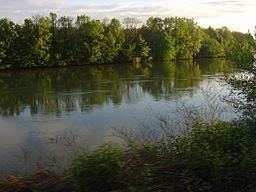- elevation 1,450 m (4,757 ft) Basin area 11,828 km² | Length 707 km Discharge 670 m³/s | |
 | ||
- average 670 m/s (23,661 cu ft/s) Bridges Old Bridge, Pedestrian bridge, Suleiman Bridge, Puh Bridge, Franjo Tuđman Bridge, Malečnik Bridge, Slomšek Bridge | ||
Maribor city on river drava
The Drava (German: Drau; Hungarian: Dráva) or Drave is a river in southern Central Europe. With a length of 749 kilometres (465 mi), it is the fourth longest tributary of the Danube. Its source is near the market town of Innichen (San Candido), in the Puster Valley of South Tyrol, Italy. The river flows eastwards through East Tirol and Carinthia in Austria into the Styria region of Slovenia. It then turns southeast, passing through Croatia and forming most of the border between Croatia and Hungary, before it joins the Danube near Osijek.
Contents
Map of Drava
Overview
In ancient times the river was known as Latin: Dravus, cf. Sanskrit: द्रवति, dravati, "flow". The name is most likely of Celtic or Illyrian origin (see Old European hydronymy). The river gives its name to the dravite species of tourmaline.
The Drava (along with one of its tributaries, the Slizza) and the Spöl are the only two rivers originating in Italy that belong to the Danube drainage basin. The Gail in Austria, the Meža and Dravinja in Slovenia, and the Bednja in Croatia from the south, as well as the Möll, the Gurk and the Lavant in Austria, and the Mur (near Legrad) in Croatia from the north are its main tributaries.
Course
The Drava sources are located at the drainage divide between the market town of Innichen and neighbouring Toblach (Dobbiaco) in the west, where the Rienz river rises, a tributary of the Adige (Etsch). The river flows eastwards and after a few kilometres reaches the border with East Tyrol in Austria. It flows through Lienz and into Carinthia at Oberdrauburg. The river separates the Kreuzeck range of the High Tauern in the north and the Gailtal Alps in the south, passes the Sachsenburg narrows and the site of the ancient city of Teurnia, before it reaches the town of Spittal an der Drau. Downstream of Villach, it runs along the northern slopes of the Karawanks to Ferlach and Lavamünd.
The Drava passes into Slovenia at Dravograd, from where it runs for 142 kilometres (88 mi) via Vuzenica, Muta, Ruše, and Maribor to Ptuj and the border with Croatia at Ormož. The river then passes Varaždin, Belišće and Osijek in Croatia, and Barcs in Hungary. It is navigable for about 90 kilometres (56 mi) from Čađavica in Croatia to its mouth.
The hydrological parameters of Drava are regularly monitored in Croatia at Botovo, Terezino Polje, Donji Miholjac and Osijek.
Hydroelectric power plants
Currently, there are 22 hydroelectric power plants on the Drava. The power plants are listed beginning at the headwaters:
